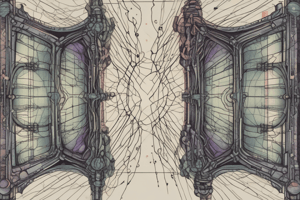Podcast
Questions and Answers
What is the main function of rods in the human eye?
What is the main function of rods in the human eye?
- Sensitive to low light (correct)
- Important for visual acuity
- Responsible for color vision
- Work best in bright light
What occurs during depolarization of a neuron?
What occurs during depolarization of a neuron?
- Sodium ions rush out of the neuron
- Sodium ions rush into the neuron (correct)
- Voltage-gated sodium channels close
- The membrane potential becomes negative
What is the typical resting membrane potential of a neuron?
What is the typical resting membrane potential of a neuron?
- -70 mV (correct)
- -40 mV
- -55 mV
- +40 mV
What is the role of the sodium-potassium pump in neurons?
What is the role of the sodium-potassium pump in neurons?
Which statement is true regarding the process of transduction in vision?
Which statement is true regarding the process of transduction in vision?
What must be reached to trigger an action potential in a neuron?
What must be reached to trigger an action potential in a neuron?
How does the perceived intensity of stimuli change with increased physical intensity?
How does the perceived intensity of stimuli change with increased physical intensity?
What is the effect of the influx of sodium ions on the neuron's membrane potential during an action potential?
What is the effect of the influx of sodium ions on the neuron's membrane potential during an action potential?
What is the primary advantage of low convergence in cones?
What is the primary advantage of low convergence in cones?
Which type of photoreceptor is primarily responsible for night vision?
Which type of photoreceptor is primarily responsible for night vision?
What happens during dark adaptation?
What happens during dark adaptation?
What is the primary trade-off between rods and cones?
What is the primary trade-off between rods and cones?
During which condition do cones struggle to function effectively?
During which condition do cones struggle to function effectively?
What are the two components that make up visual pigment molecules in the retina?
What are the two components that make up visual pigment molecules in the retina?
Which statement correctly describes rods in relation to vision?
Which statement correctly describes rods in relation to vision?
What best explains the role of convergence in the visual system?
What best explains the role of convergence in the visual system?
What is the primary issue faced by individuals with hyperopia?
What is the primary issue faced by individuals with hyperopia?
Which symptom is associated with retinitis pigmentosa during its early stages?
Which symptom is associated with retinitis pigmentosa during its early stages?
What happens to the lens of the eye when focusing on a nearby object?
What happens to the lens of the eye when focusing on a nearby object?
What is the role of convergence in the eye?
What is the role of convergence in the eye?
What is one disadvantage of high convergence in rods?
What is one disadvantage of high convergence in rods?
Which eye part is primarily responsible for providing focusing power?
Which eye part is primarily responsible for providing focusing power?
What condition does macular degeneration primarily affect?
What condition does macular degeneration primarily affect?
What is the result of the lens flattening when focusing on distant objects?
What is the result of the lens flattening when focusing on distant objects?
What is the primary purpose of visual transduction?
What is the primary purpose of visual transduction?
Which structure in the retina has the highest sensitivity to light?
Which structure in the retina has the highest sensitivity to light?
How do cones and rods differ in their convergence onto ganglion cells?
How do cones and rods differ in their convergence onto ganglion cells?
What role do horizontal and amacrine cells play in the retina?
What role do horizontal and amacrine cells play in the retina?
What is the effect of dark adaptation on the eyes?
What is the effect of dark adaptation on the eyes?
Which statement correctly describes the vertical system in the retina?
Which statement correctly describes the vertical system in the retina?
What is the primary function of regeneration in the context of visual transduction?
What is the primary function of regeneration in the context of visual transduction?
What is the main contribution of convergence in the retinal structure?
What is the main contribution of convergence in the retinal structure?
What does double dissociation demonstrate about two cognitive functions?
What does double dissociation demonstrate about two cognitive functions?
Which of the following best describes Broca's Aphasia?
Which of the following best describes Broca's Aphasia?
What is the role of the ventral pathway in the visual system?
What is the role of the ventral pathway in the visual system?
What occurs in the brain after visual information is processed by the retina?
What occurs in the brain after visual information is processed by the retina?
What does the presence of double dissociation between Broca's and Wernicke's areas indicate?
What does the presence of double dissociation between Broca's and Wernicke's areas indicate?
Which of the following statements is true regarding single dissociation compared to double dissociation?
Which of the following statements is true regarding single dissociation compared to double dissociation?
What is the primary function of the dorsal pathway in the visual system?
What is the primary function of the dorsal pathway in the visual system?
Which area of the brain is associated with speech comprehension impairment in Wernicke's Aphasia?
Which area of the brain is associated with speech comprehension impairment in Wernicke's Aphasia?
Flashcards are hidden until you start studying
Study Notes
Perception and Sensory Processing
- Increased physical stimulus intensity leads to smaller increases in perceived intensity (psychophysical principle).
- Response expansion occurs when perception increases faster than stimulus intensity, notably in experiences of pain and fear.
Transduction
- Transduction describes how photoreceptors (rods and cones) convert light into electrical signals in the retina.
- Rods are sensitive to low light and essential for night vision.
- Cones are responsible for color vision and visual acuity.
Action Potentials
- An action potential is an electrical signal produced by ion movement (Na+, K+) across a neuron's membrane.
- Resting potential is when a neuron is at rest, typically around -70 mV, with a negative charge inside.
- Sodium (Na⁺) is higher outside the cell, while potassium (K⁺) is concentrated inside; the sodium-potassium pump maintains this balance.
Visual Impairments
- Hyperopia (farsightedness) occurs when the eyeball is too short, making nearby objects difficult to focus on.
- Retinitis Pigmentosa (RP) is a genetic disorder that causes night blindness and peripheral vision loss, eventually leading to tunnel vision or blindness.
- Macular degeneration affects the central retina (macula), causing a loss of central vision while peripheral vision remains intact.
Accommodation
- Accommodation is the lens's ability to change shape, becoming thicker for near objects and thinner for distant objects, enabling focus on the retina.
Parts of the Eye
- The cornea provides most of the eye's focusing power.
- The lens adjusts shape for focused light.
- The retina contains rods and cones for light detection.
- The optic nerve transmits visual information to the brain.
Convergence in Vision
- High convergence is common in rods, enhancing sensitivity to light but reducing acuity.
- Low convergence, particularly in cones (especially in the fovea), leads to higher acuity, beneficial for detail recognition but lower sensitivity in dim light.
- Trade-off: rods favor sensitivity (ideal for night vision) while cones favor acuity (sharp vision in daylight).
Dark and Light Adaptation
- Dark adaptation increases eye sensitivity to low light by regenerating photopigments in rods.
- Light adaptation involves reducing sensitivity during bright light exposure.
- Visual pigment molecules in photoreceptors include opsin and retinal, critical for converting light into electrical signals.
Organization of Retinal Layers
- Five major cell types in the retina: photoreceptors, bipolar cells, ganglion cells, horizontal cells, and amacrine cells.
- The vertical system of the retina processes information by moving signals from photoreceptors to ganglion cells.
- The horizontal system integrates signals across photoreceptors, enhancing contrast through lateral inhibition.
Double Dissociations
- Double dissociations demonstrate that two cognitive functions (e.g., object recognition vs. spatial processing) rely on distinct neural pathways.
- Broca’s Aphasia results from damage to Broca’s area, impairing speech production while comprehension remains intact.
- Wernicke’s Aphasia occurs due to damage to Wernicke’s area, impairing comprehension while leaving speech production intact, albeit nonsensical.
Visual Pathways
- Visual information travels from the retina to the Lateral Geniculate Nucleus (LGN) and then to the Primary Visual Cortex (V1).
- The ventral pathway processes object identity (what), while the dorsal pathway processes spatial location and motion (where/how).
Studying That Suits You
Use AI to generate personalized quizzes and flashcards to suit your learning preferences.




